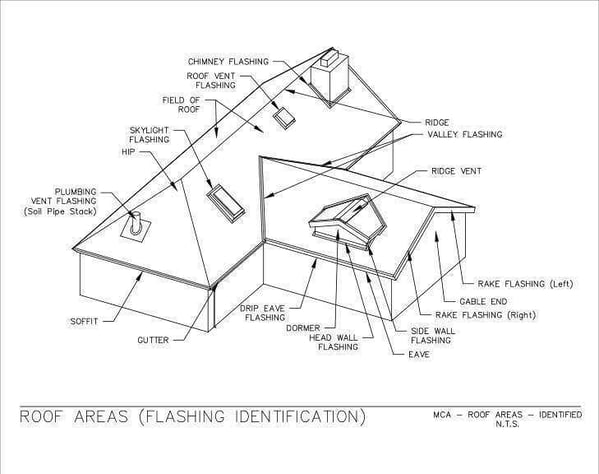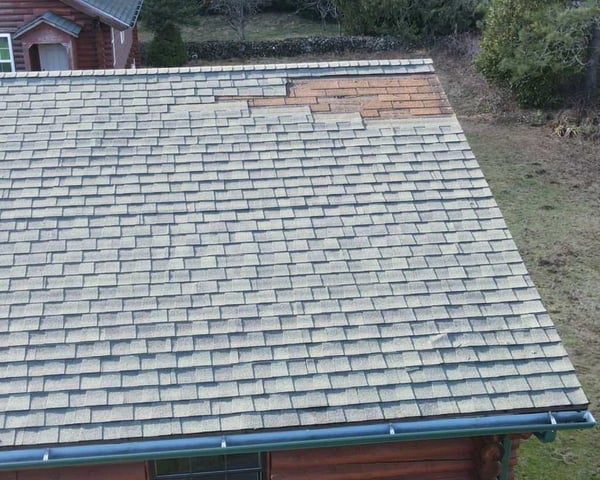Setting the Stage: Why can I see the nails?
Here is an image that illustrates the concept of a soffit:

1 The image shows the underside of a roof’s overhang, typically known as the soffit.
“Why are the nails poking through?”
If you’ve ever had to utter these words then you know how frustrating it can be. Unfortunately, one of the more common things in west coast building practices is exposed roof overhangs/open soffits. Why is this more prevalent on the west coast? Back east and in the Midwest, houses are older. Labor was cheaper “Back in the day” and the local styles have more trim. More detail. More finish. West coast homes tend to be newer than 1970, on average. These homes are built with cost-cutting measures in labor. Easiest way to save money? Do less work. That translates into soffits that are left bare. You can see the rafters and the bottom of the roof deck. It works just fine, but it does lead to unsightly nails poking through the plywood.
This typically shows up when roofing is replaced and the roof deck is not at least 3/4″ thick, leading to nails protruding through the roof deck—even at the overhangs. This might sound like a careless mistake, but surprisingly, it’s actually correct installation according to international residential building codes, specifically R905.2.5. Nails must penetrate into the roof deck at least ¾”, or penetrate through.
The Seattle Scenario: A Case of Half Inch Roof Sheathing
In the Seattle area this issue is particularly prevalent. Much of the roof sheathing here is only 1/2″ thick (or even 7/16″), which might seem like a builder’s oversight but it’s quite common and typically still within structural guidelines. In the Seattle area, the soffits (the underside of a building overhang) are often exposed with nothing to enclose them. So when you look up, you won’t see a finished soffit but the underside of the roof deck itself. And yes, you’re going to see nails if the roof is installed properly.
Here is an image that portrays the condition of nails protruding through the roof deck at the overhang:




The image above presents a clear view of nails coming through a roof deck in the overhang. This is a common sight in homes with thinner roof sheathing, especially in areas like Seattle. Although it may appear concerning it is important to remember that this is in line with the IRC (International Residential Building Code) which all contractors must adhere to. The protrusion indicates a properly nailed roof.
How to Resolve: Solutions for Dealing with Nails Sticking Through
So, what is the solution? Of course, one option is to upgrade the roof decking before starting your shingle installation. This could require a new layer of plywood sheathing and additional fastening costs. But if that isn’t a viable option—or if you’re already in the middle of an existing roof installation—then your better option is to enclose the soffit.
How to Handle The Nail Protrusion: Paint, Enclose, or Accept
So you’ve got a nail protrusion problem. What do you do? The answer depends on your personal preferences and budget. The first option is to paint over the nails. This is a cost-effective solution that can help the nails blend into the roof, making them less noticeable. Another option is to enclose the soffits. This is a more extensive project that will hide the nails completely but can be more costly. It’s a carpentry project.




Finally, you could choose to live with it. After all, the nails are only doing their job—keeping your roof intact!
Customer Testimonial: The Power of Acceptance
One of our valued customers, John, recounts his experience
“At first, seeing the nails sticking out from my roof was a bit of an eyesore. But when the team at RoofSmart explained why they were there and reassured me it wasn’t a mistake I felt unsure. My old roof had been stapled in, so it was blowing off in places. Now that the new roof is on and the overhangs are painted I don’t even notice them anymore”

Roofing: More Than Meets the Eye
In conclusion, mastering roofing is a complex business with a lot of nuance. There’s a lot more to it than just shingles and gutters to make a project turn out better than expected. Whether it’s understanding the nuances of building codes like R905.2.5, grappling with regional differences like the Seattle half-inch sheathing, or learning to live with the quirks of your roof like nail point protrusion in the overhang, it all contributes to the fascinating world of roofing. And as always, we’re here to guide you through it. After all, we’re not just roofing experts—we’re your Meticulous Roofing Nerds. Here to give you the best darn roof we can.
Ready to Embrace Your Roof’s Quirks?
Whether you decide to paint, enclose, or live with your roof’s quirks, remember: your roof is more than just a shield from the elements. It’s a testament to the intricate world of construction, a symbol of the home you’ve built, and yes—sometimes, it’s even a canvas for protruding nails. So here’s to embracing our roofs, nails and all!
Jim Singleterry
Jim Singleterry is the CEO and founder of RoofSmart. He is passionate about getting to the root of each customer's roofing problems and helping them find the right solution for their roof.











